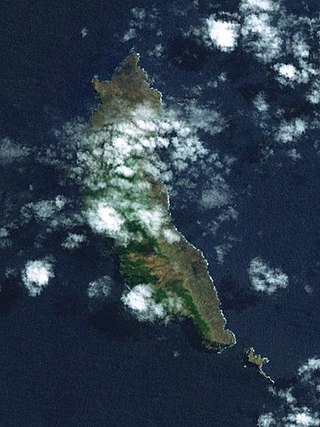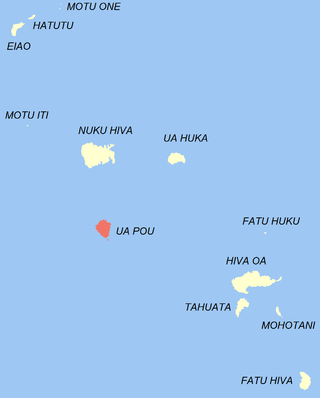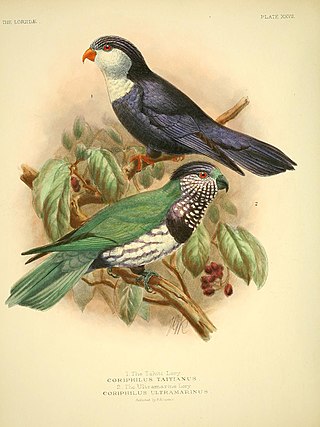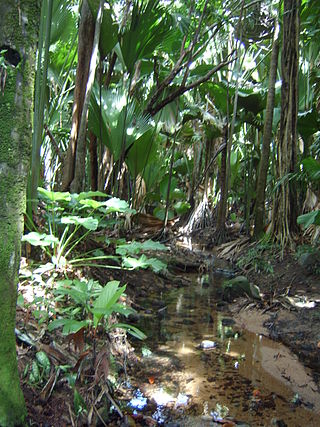Related Research Articles

The Marquesas Islands are a group of volcanic islands in French Polynesia, an overseas collectivity of France in the southern Pacific Ocean. Their highest point is the peak of Mount Oave on Ua Pou island, at 1,230 m (4,035 ft) above sea level.

Lodoicea, commonly known as the sea coconut, coco de mer, or double coconut, is a monotypic genus in the palm family. The sole species, Lodoicea maldivica, is endemic to the islands of Praslin and Curieuse in the Seychelles. It has the largest seed in the plant kingdom. It was also formerly found on the small islets of St Pierre, Chauve-Souris, and Ile Ronde, all located near Praslin, but had become extinct there for a time until recently reintroduced.

Fatu-Hiva is the southernmost island of the Marquesas Islands in French Polynesia, an overseas territory of France in the Pacific Ocean. With Motu Nao as its closest neighbour, it is also the most isolated of the inhabited islands.

With its 320 square kilometres, Hiva Oa is the second largest island in the Marquesas Islands, in French Polynesia, an overseas territory of France in the Pacific Ocean. Located at 9 45' south latitude and 139 W longitude, it is the largest island of the southern Marquesas group. Around 2,200 people reside on the island. A volcano, Temetiu, is Hiva Oa's highest point with 1,200 metres.

Mohotani is an uninhabited island southeast of Hiva Oa and east of Tahuata in the southern Marquesas Islands. It has an area of 15 km2. Much of the island's sparse vegetation has been destroyed by feral goats and sheep, to the extent that following its rare rains, the sea around it is stained red from runoff. Early reports describes the island as fertile, with forest and fields. When Thor Heyerdahl visited the island in 1938, there were only a few goats and remains of deserted huts and villages.

Ua Pou is the third largest of the Marquesas Islands, in French Polynesia, an overseas territory of France in the Pacific Ocean.

Ua Huka is one of the Marquesas Islands, in French Polynesia, an overseas territory of France in the Pacific Ocean. It is situated in the northern group of the archipelago, approximately 25 mi (40 km) to the east of Nuku Hiva, at 8°54′S139°33′W.
Bactris jamaicana is a spiny palm which grows in multi-stemmed clumps. It is endemic to Jamaica.

Pseudophoenix is a genus of palms which is native to the wider Caribbean. Three species of the four species are endemic to Hispaniola, while the fourth, P. sargentii, is widely distributed in the northern Caribbean, Florida, and the Yucatán Peninsula.

Juania australis, the Chonta palm, is a species of flowering plant in the family Arecaceae, the only species in the genus Juania. It is a solitary trunked palm tree which is endemic to the Juan Fernández Islands archipelago in the southeast Pacific Ocean west of Chile.

Pelagodoxa is a genus of palm tree. It includes two species, P. henryana, which is native to the Marquesas Islands of French Polynesia, and P. mesocarpa, which is native to Vanuatu.

The ultramarine lorikeet is a species of parrot in the family Psittaculidae, endemic to the Marquesas Islands. Its natural habitats are subtropical or tropical moist lowland forest, subtropical or tropical moist montane forest and plantations. It is critically endangered, threatened mainly by introduction of the black rat and by deforestation.

The Paleotropical kingdom (Paleotropis) is a floristic kingdom composed of the tropical areas of Africa, Asia and Oceania, as proposed by Ronald Good and Armen Takhtajan. Part of its flora is inherited from the ancient supercontinent of Gondwana or exchanged later. These Gondwanan lineages are related to those in the Neotropical kingdom, composed of the tropical areas of Central and South America. Flora from the Paleotropical kingdom influenced the tropical flora of the Australian Kingdom. The kingdom is subdivided into five floristic subkingdoms according to Takhtajan and about 13 floristic regions. In this article the floristic subkingdoms and regions are given as delineated by Takhtajan.

The wildlife of Seychelles comprises the flora and fauna of the Seychelles islands off the eastern coast of Africa in the western Indian Ocean.

Pelagodoxa henryana is a species of palm tree. It is native to French Polynesia, where it survives on Nuku Hiva in the Marquesas Islands. A population on Raivavae in the Tubuai Islands is presumed extinct. The species is threatened by habitat loss.

The wildlife of Greece includes the diverse flora, fauna, and funga of Greece, a country in southern Europe. The country is mostly mountainous with a very long, convoluted coastline, consisting of peninsulas and many islands. The climate ranges from Mediterranean through temperate to alpine, and the habitats include mountains, hills, forests, rivers, lakes, coasts and cultivated land.

The flora of French Polynesia refers to the native vegetation of the Marquesas Islands, the Tuamotu Archipelago, the Society Islands and the Tubuai Islands, located in Oceania. Due to its type of vegetation, French Polynesia falls within the palaeotropic floral kingdom.

The Marquesas tropical moist forests is a tropical and subtropical moist broadleaf forests ecoregion in the Marquesas Islands of French Polynesia.

Pelagodoxeae is a tribe of plants in the family Arecaceae found in Oceania, namely in New Guinea and the Marquesas Islands. The tribe has two monotypic genera, which are:
References
- ↑ Dransfield, John; Uhl, Natalie W.; Asmussen, Conny B.; Baker, William J.; Harley, Madeline M.; Lewis, Carl E. (2008). Genera Palmarum: The Evolution and Classification of Palms. Royal Botanic Gardens, Kew. ISBN 978-1-84246-182-2.